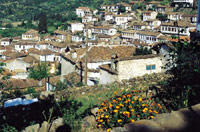|
|
|
|
Vedius Gymnasium it is built by a rich ephesusian at the 2nd century AC for the name of Vedius Antonius. It an magnificence building that sportive and cultural education was given and characterise the periods properties by its courtyard at east, ceremony saloon placed at middle, dressing room and public baths.
|
Stadium after the Vedius Gymnasium through the ruins there is a stadium at the left. Stadium that all races, games, Olympic organisations done in side, was occupying all the sportive and cultural needs of period. Acropolis there is a building dated to 6th century BC on a hill known as Acropolis at opposite side to stadium. There is a temple dated to years of 350 BC at north - west of the hill.
Byzantine Public Baths After Stadium way coming across to the Byzantines public baths.
Cifte Churches (double Church) Cifte Church take place towards the Byzantines public baths, has a very specific importance for Christianity. Church that kosuls were meeting at the years of 431 - 438, is an 265 x 29.5 m. sized building. Building at the 11th century in the Roman period turned to a bazilika, dedicated to the Virgin Mary. At the 3rd consul meeting assembled here the foundation of Catholicism decision given. Church is keeps its importance today too by the means of the property that it is one of the first seven churches of Christianity.
|
|
|
|
At the 7th century AC and second church built by opening a door on old churches apsis by the way churches name began to known as "Cifte (double) Churches". This newly opened section preserves the sites for cleric residence. It and surrounding's are religious centre because of the church is the first church dedicated to the Virgin Mary.
|
theatre one of the most beautiful buildings of Ephesus ruins, remained very healthy and since recent time it was easily used for festivals similar to Ephesus Festival. Theatre with 25.000 capacity known that first built at Hellenistic period, however the theatre remained to present day's re - construction began at times of Empire Cladius, and finalised at the years of 98 -117 in empire Trianus period.
|
|
|
|
there is the Virgin Mary house of Christianity on Mount Bulbul. The holy place named ''Panaya Kapulu'' by Christians too, estimated to be built at 4th AC century. the Jesus Christ commend his mother to his apostle and friend St. Jean a little time before his arresting and crucifying. St. Jean found inconvenient to live at Jerusalem for the Virgin Mary after the Jesus Christ crucifying, so he take her with him to this place. St. Jean whom undertake a holy mission of broadcasting Christianity, take target ephesus one of the most huge cities of age and because of his desire to don't settle the Virign Mary to an idolaters city he hide Her in a house on the slope of Mount Bülbül covered with dense trees.
|
Basilisca that built by Byzantine Empire Justinyen for the name of St. Jean at 6th AC, is take place on Ayasuluk hill. Cross planed building have entrance at west is 40 X 110 m. sized, and an domed type basilica.
|
|
|
|
It is known that first ephesus settlements was built around these temple place. Temple collapsed by an earth quake than ephesusians built temple more imposing by the support of Roman empire. Ephesus Artemis Temple known as one of the seven wonders of world today only base ruins remained.
|
Seven sleepers ruin place estimated that buildind built at in to 5th and 6th BC centuries period is an religious center place. According to rumor before the acceptance of Christianity as official religion, seven young man escape from idolaters take refuge here and sleep for 2 centuries than woke up. When they woke up the Christianity accepted as official religion. It is estimated about this miracle event, after those seven young man dies they buried the same place and a building built in the name of them. Today building bring to light by excavations, has very huge monumental size and lots of rock engraved tombs, two churches and catacombs can be found.
|
|
|

|
Isa Bey Mosque is at Ayasuluk hill on west slope of St. Jean Basilica, is an Seljuklian period building. It is built by Isa Bey at the year of 1375.
|
|
Sirince Village 7 km away from Selcuk preserve its residence properties remains from last century. It is an nostalgia village with fruits, wines, traditional delicious meals, authentic structure and life style.
|
|